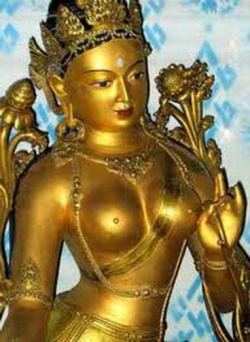Bodhisattva definition
In Buddhist thought, a Bodhisattva (Ch.: 菩薩 pú sà, Jp.: bosatsu) is a being who is dedicated to achieving complete Buddhahood. That is their reason for "being" or raison d'être. Conventionally, the term is applied to hypothetical beings with a high degree of enlightenment. Bodhisattva literally means an "enlightenment (bodhi) being (sattva)" in Sanskrit.
The following is a partial list of bodhisattvas, respected in Indian, Mongolian, Tibetan, Japanese and Chinese traditions.
List of bodhisattvas
(Ch. 虛空藏 , Xu Kong Zang, Kr. Huh Gong Zang, Jp. Kokuzo) - The Bodhisattva of infinite happiness generated by helping countless numbers of sentient beings.
(Ch. 觀音 , Guan Yin, Kr. Guan Um, Jp. Kannon, Tib. Chenrezig, Viet. Quán Thế Âm) - The bodhisattva of compassion, the listener of the world's cries who uses skillful means to come to their aid; the most universally acknowledged Bodhisattva in Mahayana Buddhism. Known as Guan Yin in East Asia, Chenrezig in Tibet, and Migjid Janraisig in Mongolia.
- Baba Saheb
Param Pujya Dr. Bhimrao Ramji Ambedkar is regarded as a Bodhisattva by Indian Buddhist Bhikkus and by millions of other Buddhists.
(Ch. 地藏 , Di Zang, Kr. Ji Zang, Jp. Jizo, Tib. Sai Nyingpo, Viet. 'Địa Tạng). The bodhisattva of the beings suffering in hellish realms, or the bodhisattva of great vows.
- Mahasthamaprapta
(Ch. 大勢至, Da Shì Zhì, Kr. Dae Sae Zhi, Jp. Seishi, Viet. Đại Thế Chí) - Represents the power of wisdom, seen on the left of Amitabha in Pure Land Buddhism.
(Ch. 彌勒 , Mi Le, Kr. Mi Ruk, Jp. Miroku, Viet. Di Lạc) - The bodhisattva to be reborn and to become enlightened, thus succeeding Gautama Buddha in the future. Known for his benevolence.
(Ch. 文殊 , Wen Shu, Kr. Moon Soo, Jp. Monju, Tib. Jampal Yang, Viet. Văn Thù) - Bodhisattva of keen awareness and wisdom.
(Ch. 龍樹, Long Shu, Viet. Long Thọ) - The founder of the Madhyamaka (Middle Path) school of Mahāyāna Buddhism.
- Niō
Two wrath-filled and muscular guardians of the Buddha, standing today at the entrance of many Buddhist temples in Japan and Korea under the appearance of frightening wrestler-like statues. They are manifestations of the Bodhisattva Vajrapani.
(Ch. 蓮華生上師, Lianhuasheng Shang Shi, Tib. Padma Jungne or Guru Rinpoche) - Most associated with Tibetan Buddhism and Bhutanese Buddhism. The Nyingma school regards Padmasambhava as a second Buddha.
(Ch. 普賢 , Pu Xian, Kr. Bo Hyun, Jp. Fugen, Tib. Kuntu Zangpo, Viet. Phổ Hiền) - Represents the practice and meditation of all Buddhas.
- Sangharama
(Ch. 伽藍, Qie Lan, Viet. Già Lam) - Only revered in Chinese Buddhism-Taoism, Sangharama refer to a group of devas who guard Buddhist monasteries and the faith, but the title is usually referring to the legendary Chinese military general Guan Yu, who became a Dharmapala through becoming a Buddhist and making vows.
8th century scholar, wrote about Bodhisattvas.
- Sitatapatra
The goddess of the White Parasol and protector against supernatural danger.
- Skanda
(Ch. 韋馱, Wei Tuo) - A Dharmapala who guards the Dharma, with links to Vajrapani and is somewhat the direct forbear to Murugan, a Hindu deity. Primarily worshipped in Chinese Buddhism.
- Supushpachandra
Mentioned in Shantideva's A Guide to the Bodhisattva's Way Of Life
- Suryavairocana
(Ch: 日光, Ri Guang, Kr. Il Guang, Jp: Nikkō) - One of two attendants of Bhaisajyaguru Buddha.
(Ch. 度母, Du Mu) - Female bodhisattva, or set of bodhisattvas, in Tibetan Buddhism. She represents the virtues of success in work and achievements. Also a manifestation of Avalokitesvara.
(Ch. 金剛手, Jin Gang Shou, Kr. Kum Kang Soo, Jp.Shukongojin, Tib. Channa Dorje) - An early bodhisattva in Mahayana.
- Vasudhara
Bodhisattva of abundance and fertility. Popular in Nepal.
